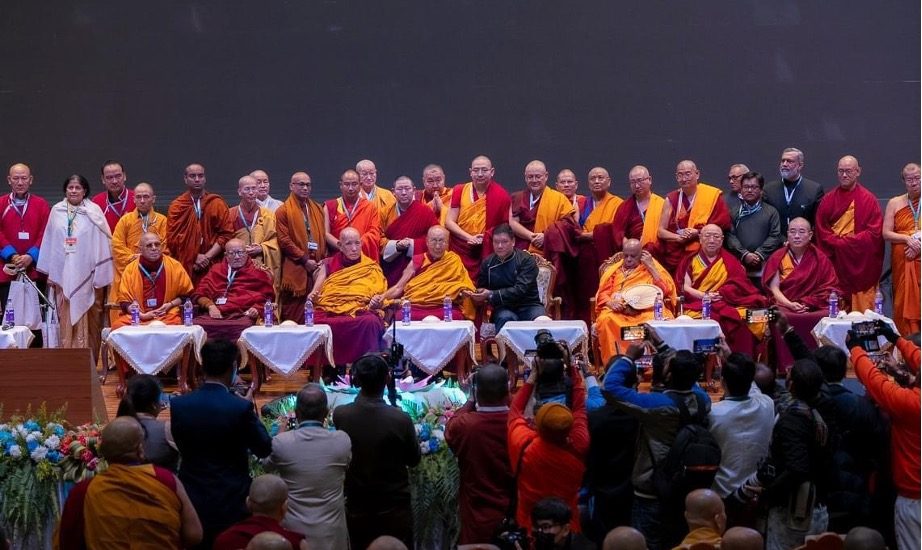By Adele Tomlin
A few months ago, I wrote a commentary piece titled, “Where Are the Women At the Global Buddhist Summit” concerning said summit in Delhi. One week ago, the press and social media reported that the 14th Dalai Lama was inaugurating a three-day International Sangha Forum on “Bridging Traditions, Embracing Modernity-A Dialogue on the Buddha’s Teaching in Today’s World” in Bodh Gaya.
It was disappointing to see yet again an all-male panel on the main stage, bar one: Gopa Maharathi, member of the Bodhgaya Temple management committee. As he is 88, it is possible that the Dalai Lama did not have much say in the people who would be on the main stage with him: his advisors and those around him would have had such authority. Thus, it is strange indeed that an international sangha event had an all-male presence on the main stage and could not find any Buddhist women or nuns to include.
In a show of seeming Gelugpa sectarianism and dominance, with the Dalai Lama and the Ganden Tripa both present at centre stage, with no other heads from the main Tibetan Buddhist lineages equally represented, such as Nyingma and Kagyu (Drugpa, Drigung, Karma). This Gelugpa hegemony is not a new phenomenon for Tibetan Buddhists in exile, or in Tibet. It is now becoming clearer, certainly with scholarly historical scrutiny, how the Gelugpas (headed by the Dalai Lama) took control of Tibet by violent force with the Mongolian military, and then harshly (and often violently) suppressed, censored and stole the property, land, and texts of the other main lineages.
As I mentioned in my article about Tibetan exile “democracy”, even to this day in exile, the Tibetan educational institutions and schools always have photos of the 14th Dalai Lama but not of the other main lineage heads. That may have been how it was done in pre-1959 Tibet, but in-exile, where is the non-sectarianism?
In addition, the main texts and view of Tibetan Buddhists in-exile has become that of Prasangika Madhyamika, at least in the institutions where predominantly Gelugpa Geshes teach. Yet, prior to that the views of Indian masters like Shantarakshita and the Yogacara-Madhyamika, and the Empty-of-Other view of the Tibetan masters were the predominant view. Yet, the Dalai Lama always preaches the importance of non-sectarianism and the importance of the Nalanda tradition of debate and giving all views a “fair hearing.”
There is one more reality we must confront: millions of people globally (including in India) were puzzled, hurt and even outraged by the Dalai Lama’s actions and speech with the Indian boy. While he admitted to his error after an outcry that reverberated across international and social media, what followed was perhaps even more alarming: an aggressive defense against individuals and against the Indian media mounted by some Tibetans, which ranged from appeals to it being ‘harmless fun’, cultural relativism and calling the act a “cultural norm” or at its most extreme calling people Chinese spies or ‘western’ racists. Ironically, the 14th Dalai Lama himself has supported a vision of universal secular ethics.
Many children’s rights experts, in particular, Asians and Indians, condemned the incident as inappropriate. Even assuming that the Dalai Lama’s intentions, were innocent and pure (though the boy clearly displayed uncomfortable body language and physically resisted the requests made), it is hard to imagine that any other powerful and influential male religious (or political) leader would have been allowed to head such major events after doing such a thing with a child or woman. Had the 14th Dalai Lama had more Tibetan female advisors and senior secretaries by his side, such a public relations disaster could have possibly been avoided. A fresh, progressive female perspective would also have served as a potential counterweight to the increasingly ossifying and outdated worldview and tactics of his supporters, whether in his inner circle or online anywhere in the world.
The Buddhist sangha, as originally founded by Shakayamuni Buddha, is a fourfold one, supposedly equal between laymen, laywomen, monks, and nuns. Yet judging by the photo of the conference, one would think that the Buddhist sangha is made of monks only. Perhaps that was the unspoken message and symbol of it all? On seeing that photo, most women might understandably not see it as a sangha for and including women. Seeing, after all, is believing.


